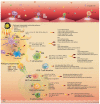New Insights into the Role of Inflammation in the Pathogenesis of Atherosclerosis
- PMID: 28937652
- PMCID: PMC5666716
- DOI: 10.3390/ijms18102034
New Insights into the Role of Inflammation in the Pathogenesis of Atherosclerosis
Abstract
Atherosclerosis is a chronic inflammatory disease characterized by the accumulation of lipids, smooth muscle cell proliferation, cell apoptosis, necrosis, fibrosis, and local inflammation. Immune and inflammatory responses have significant effects on every phase of atherosclerosis, and increasing evidence shows that immunity plays a more important role in atherosclerosis by tightly regulating its progression. Therefore, understanding the relationship between immune responses and the atherosclerotic microenvironment is extremely important. This article reviews existing knowledge regarding the pathogenesis of immune responses in the atherosclerotic microenvironment, and the immune mechanisms involved in atherosclerosis formation and activation.
Keywords: atherosclerosis; atherosclerotic immunity; atherosclerotic microenvironment; macrophage; oxidative stress.
Conflict of interest statement
The authors declare no conflict of interest.
Figures



Similar articles
-
Functional diversity of macrophages in vascular biology and disease.Vascul Pharmacol. 2017 Dec;99:13-22. doi: 10.1016/j.vph.2017.10.005. Epub 2017 Oct 24. Vascul Pharmacol. 2017. PMID: 29074468 Review.
-
Atherosclerosis--do we know enough already to prevent it?Curr Opin Pharmacol. 2016 Apr;27:92-102. doi: 10.1016/j.coph.2016.02.006. Epub 2016 Mar 12. Curr Opin Pharmacol. 2016. PMID: 26974701 Review.
-
Crosstalk between red blood cells and the immune system and its impact on atherosclerosis.Biomed Res Int. 2015;2015:616834. doi: 10.1155/2015/616834. Epub 2015 Feb 4. Biomed Res Int. 2015. PMID: 25722984 Free PMC article. Review.
-
Differentiation factors and cytokines in the atherosclerotic plaque micro-environment as a trigger for macrophage polarisation.Thromb Haemost. 2011 Nov;106(5):763-71. doi: 10.1160/TH11-05-0320. Epub 2011 Sep 22. Thromb Haemost. 2011. PMID: 21947328 Review.
-
Macrophages and Their Contribution to the Development of Atherosclerosis.Results Probl Cell Differ. 2017;62:273-298. doi: 10.1007/978-3-319-54090-0_11. Results Probl Cell Differ. 2017. PMID: 28455713 Review.
Cited by
-
Mitophagy in Human Diseases.Int J Mol Sci. 2021 Apr 9;22(8):3903. doi: 10.3390/ijms22083903. Int J Mol Sci. 2021. PMID: 33918863 Free PMC article. Review.
-
Humanin Ameliorates Free Fatty Acid-Induced Endothelial Inflammation by Suppressing the NLRP3 Inflammasome.ACS Omega. 2020 Aug 26;5(35):22039-22045. doi: 10.1021/acsomega.0c01778. eCollection 2020 Sep 8. ACS Omega. 2020. PMID: 32923762 Free PMC article.
-
Breath Analysis via Gas Chromatography-Mass Spectrometry (GC-MS) in Chronic Coronary Syndrome (CCS): A Proof-of-Concept Study.J Clin Med. 2024 Oct 1;13(19):5857. doi: 10.3390/jcm13195857. J Clin Med. 2024. PMID: 39407917 Free PMC article.
-
Inflammation as a Therapeutic Target in Atherosclerosis.J Clin Med. 2019 Jul 26;8(8):1109. doi: 10.3390/jcm8081109. J Clin Med. 2019. PMID: 31357404 Free PMC article. Review.
-
Ferroptosis Signaling and Regulators in Atherosclerosis.Front Cell Dev Biol. 2021 Dec 16;9:809457. doi: 10.3389/fcell.2021.809457. eCollection 2021. Front Cell Dev Biol. 2021. PMID: 34977044 Free PMC article. Review.
References
Publication types
MeSH terms
LinkOut - more resources
Full Text Sources
Other Literature Sources
Medical

